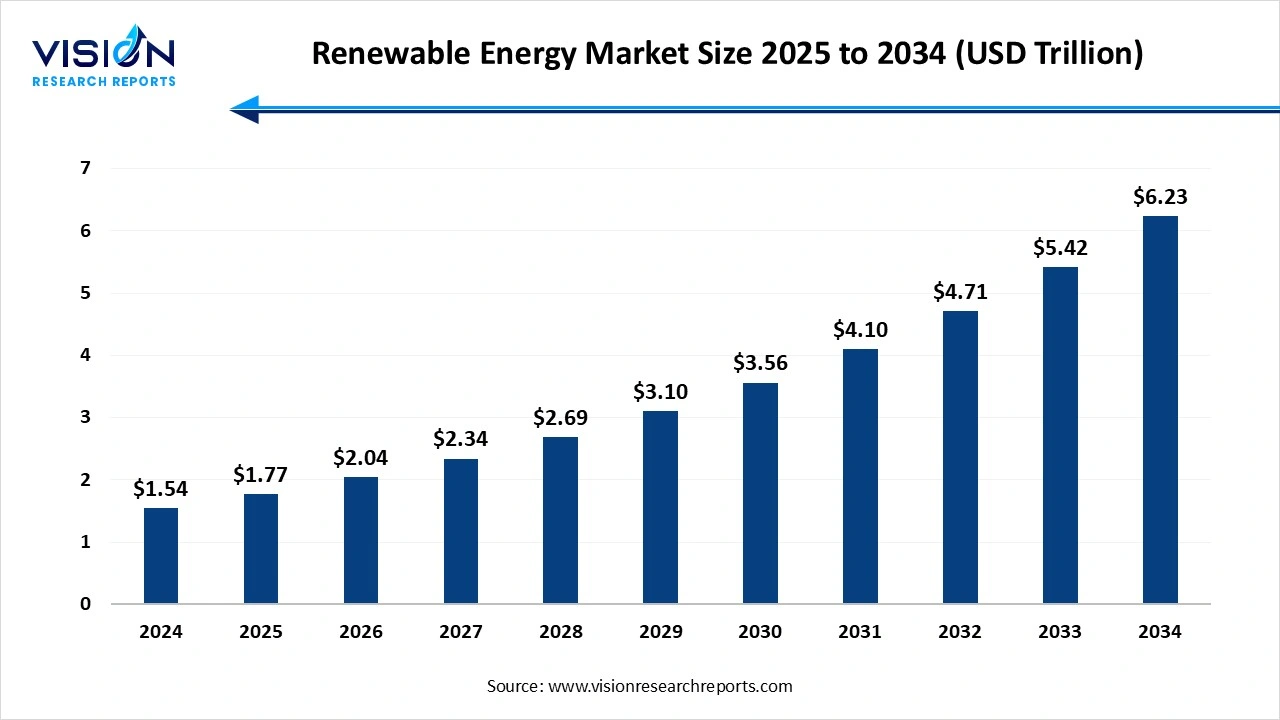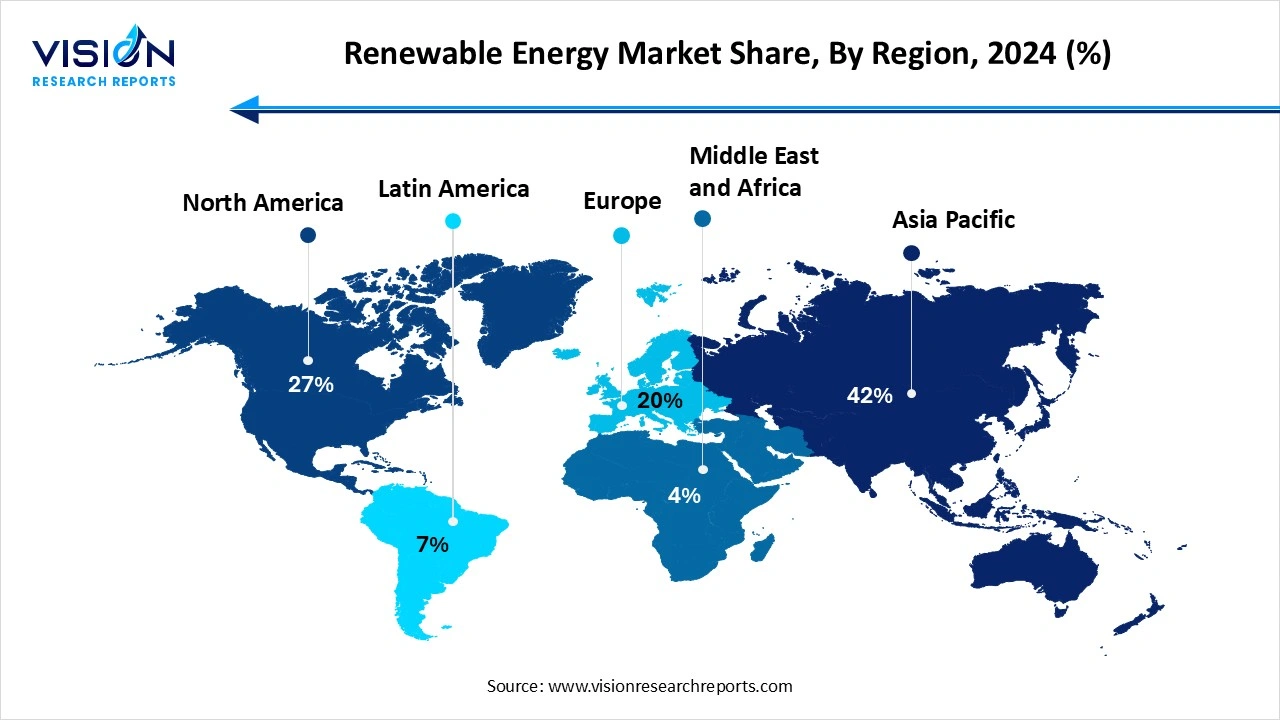The global renewable energy market size was estimated at around USD 1.54 trillion in 2024 and it is projected to hit around USD 6.23 trillion by 2034, growing at a CAGR of 15% from 2025 to 2034. The market growth is driven by increasing global emphasis on decarbonization, supportive government policies, and rising investments in clean energy infrastructure, the renewable energy market is witnessing robust growth.

The global renewable energy market has witnessed remarkable growth in recent years, driven by increasing concerns over climate change, rising demand for sustainable energy sources, and supportive government policies. Renewable energy technologies such as wind, solar, hydro, and bioenergy are rapidly replacing conventional fossil fuels due to their lower environmental impact and long-term cost benefits. Advancements in grid infrastructure, energy storage, and digital technologies have further accelerated the integration of renewables into national energy systems. In addition, international agreements like the Paris Climate Accord have prompted countries to set ambitious carbon neutrality goals, boosting investments in clean energy infrastructure.
One of the primary growth drivers of the renewable energy market is the increasing global focus on reducing greenhouse gas emissions and combating climate change. Governments worldwide are implementing strict environmental regulations and offering incentives such as tax credits, feed-in tariffs, and subsidies to promote the adoption of clean energy sources. International commitments, including the Paris Agreement and net-zero targets, have accelerated the shift from fossil fuels to renewable alternatives..
Another significant factor contributing to the market’s growth is technological advancement. Innovations in energy storage, smart grids, and digital monitoring systems have enhanced the efficiency, reliability, and scalability of renewable energy solutions. The integration of artificial intelligence and IoT in energy management has enabled better demand forecasting and real-time system optimization.
One of the major challenges in the renewable energy market is the intermittent and variable nature of renewable power sources like solar and wind. Since these energy sources are dependent on weather conditions and time of day, they cannot guarantee a consistent power supply without adequate storage solutions. This intermittency creates grid management issues and requires advanced infrastructure for balancing energy supply and demand. In many regions, the lack of reliable and cost-effective energy storage systems remains a barrier to the widespread integration of renewables into the power grid.
Another significant challenge is the high upfront capital investment required for developing renewable energy infrastructure. Although operational costs are low, the initial setup covering land acquisition, technology installation, and grid connectivity can be prohibitively expensive, especially for developing countries.
The Asia Pacific region held the market with highest share of 42% in 2024, Remains at the forefront of the global renewable energy market, fueled by rapid capacity expansion, robust government policies, and substantial investments in solar, wind, hydropower, and biomass initiatives. Countries such as China and India have invested heavily in solar and wind projects, supported by large-scale government initiatives, technological advancements, and growing private sector participation. China, in particular, dominates the global solar manufacturing landscape and continues to lead in installed renewable energy capacity.
 North America led by the United States and Canada is experiencing substantial growth due to favorable tax incentives, renewable portfolio standards, and rising corporate investments in clean energy. The U.S. Inflation Reduction Act has particularly accelerated renewable energy development across the country.
North America led by the United States and Canada is experiencing substantial growth due to favorable tax incentives, renewable portfolio standards, and rising corporate investments in clean energy. The U.S. Inflation Reduction Act has particularly accelerated renewable energy development across the country.
The solar sub-segment led the product category within the renewable energy market, capturing a revenue share of 24% in 2024. The widespread adoption of solar photovoltaic (PV) technology, driven by declining equipment costs, enhanced efficiency, and favorable government policies, has significantly accelerated the deployment of solar power systems across residential, commercial, and utility-scale applications. Technological innovations such as bifacial modules, perovskite solar cells, and floating solar farms have further enhanced the performance and adaptability of solar solutions in diverse geographic and climatic conditions.
The Within the solar power category, sub-segments such as rooftop solar, ground-mounted systems, and off-grid solar solutions are gaining traction worldwide. Rooftop solar, in particular, has witnessed increasing demand from residential and commercial sectors due to its potential to reduce electricity bills and support decentralized energy generation. Ground-mounted utility-scale solar farms continue to contribute significantly to national energy targets, especially in countries with high solar irradiance.
The industrial sub-segment accounted for the highest revenue share of 62% in 2024. The industrial sector represents one of the most significant applications in the global renewable energy market, as manufacturers and large-scale operations increasingly turn to clean energy sources to reduce operational costs and meet sustainability targets. Renewable energy is being integrated into industrial processes such as heating, cooling, and machinery operations, helping reduce reliance on fossil fuels and minimizing carbon footprints. Many industries are also adopting on-site renewable installations, such as solar rooftops and biomass systems, to ensure energy security and regulatory compliance.
The energy sector, renewable sources are playing an essential role in reshaping the global power generation landscape. Utilities are transitioning from traditional coal and gas plants to renewable-based energy portfolios to meet national clean energy goals and reduce greenhouse gas emissions. Solar, wind, hydro, and other renewable technologies are now central to energy generation, supported by advancements in smart grid infrastructure and energy storage systems that enable more stable and efficient electricity delivery.
By Product
By Application
By Regional
Chapter 1. Introduction
1.1. Research Objective
1.2. Scope of the Study
1.3. Definition
Chapter 2. Research Methodology
2.1. Research Approach
2.2. Data Sources
2.3. Assumptions & Limitations
Chapter 3. Executive Summary
3.1. Market Snapshot
Chapter 4. Market Variables and Scope
4.1. Introduction
4.2. Market Classification and Scope
4.3. Industry Value Chain Analysis
4.3.1. Raw Material Procurement Analysis
4.3.2. Sales and Distribution Channel Analysis
4.3.3. Downstream Buyer Analysis
Chapter 5. COVID 19 Impact on Renewable Energy Market
5.1. COVID-19 Landscape: Renewable Energy r Industry Impact
5.2. COVID 19 - Impact Assessment for the Industry
5.3. COVID 19 Impact: Major Government Policy
5.4. Market Trends and Opportunities in the COVID-19 Landscape
Chapter 6. Market Dynamics Analysis and Trends
6.1. Market Dynamics
6.1.1. Market Drivers
6.1.2. Market Restraints
6.1.3. Market Opportunities
6.2. Porter’s Five Forces Analysis
6.2.1. Bargaining power of suppliers
6.2.2. Bargaining power of buyers
6.2.3. Threat of substitute
6.2.4. Threat of new entrants
6.2.5. Degree of competition
Chapter 7. Competitive Landscape
7.1.1. Company Market Share/Positioning Analysis
7.1.2. Key Strategies Adopted by Players
7.1.3. Vendor Landscape
7.1.3.1. List of Suppliers
7.1.3.2. List of Buyers
Chapter 8. Renewable Energy Market, By Product
8.1. Renewable Energy Market, by Product, 2024-2033
8.1.1. Hydropower
8.1.1.1. Market Revenue and Forecast (2021-2033)
8.1.2. Wind
8.1.2.1. Market Revenue and Forecast (2021-2033)
8.1.3. Solar
8.1.3.1. Market Revenue and Forecast (2021-2033)
8.1.4. Bioenergy
8.1.4.1. Market Revenue and Forecast (2021-2033)
8.1.5. Others
8.1.5.1. Market Revenue and Forecast (2021-2033)
Chapter 9. Renewable Energy Market, By Application
9.1. Renewable Energy Market, by Application, 2024-2033
9.1.1. Industrial
9.1.1.1. Market Revenue and Forecast (2021-2033)
9.1.2. Commercial
9.1.2.1. Market Revenue and Forecast (2021-2033)
9.1.3. Residential
9.1.3.1. Market Revenue and Forecast (2021-2033)
Chapter 10. U.S. Pharmaceutical Water Market, Regional Estimates and Trend Forecast
10.1. U.S.
10.1.1. Market Revenue and Forecast, by Product (2021-2033)
10.1.2. Market Revenue and Forecast, by Application (2021-2033)
Chapter 11. Company Profiles
11.1. NextEra Energy, Inc.
11.1.1. Company Overview
11.1.2. Product Offerings
11.1.3. Financial Performance
11.1.4. Recent Initiatives
11.2. Iberdrola, S.A.
11.2.1. Company Overview
11.2.2. Product Offerings
11.2.3. Financial Performance
11.2.4. Recent Initiatives
11.3. Orsted A/S
11.3.1. Company Overview
11.3.2. Product Offerings
11.3.3. Financial Performance
11.3.4. Recent Initiatives
11.4. Enel S.p.A.
11.4.1. Company Overview
11.4.2. Product Offerings
11.4.3. Financial Performance
11.4.4. LTE Scientific
11.5. Vestas Wind Systems A/S
11.5.1. Company Overview
11.5.2. Product Offerings
11.5.3. Financial Performance
11.5.4. Recent Initiatives
11.6. Siemens Gamesa Renewable Energy, S.A.
11.6.1. Company Overview
11.6.2. Product Offerings
11.6.3. Financial Performance
11.6.4. Recent Initiatives
11.7. Canadian Solar Inc.
11.7.1. Company Overview
11.7.2. Product Offerings
11.7.3. Financial Performance
11.7.4. Recent Initiatives
11.8. First Solar, Inc.
11.8.1. Company Overview
11.8.2. Product Offerings
11.8.3. Financial Performance
11.8.4. Recent Initiatives
11.9. General Electric
11.9.1. Company Overview
11.9.2. Product Offerings
11.9.3. Financial Performance
11.9.4. Brookfield Renewable Partners L.P.
11.10. Nexus Pharmaceuticals
11.10.1. Company Overview
11.10.2. Product Offerings
11.10.3. Financial Performance
11.10.4. Recent Initiatives
Chapter 12. Research Methodology
12.1. Primary Research
12.2. Secondary Research
12.3. Assumptions
Chapter 13. Appendix
13.1. About Us
13.2. Glossary of Terms
 Cross-segment Market Size and Analysis for
Mentioned Segments
Cross-segment Market Size and Analysis for
Mentioned Segments
 Additional Company Profiles (Upto 5 With No Cost)
Additional Company Profiles (Upto 5 With No Cost)
 Additional Countries (Apart From Mentioned Countries)
Additional Countries (Apart From Mentioned Countries)
 Country/Region-specific Report
Country/Region-specific Report
 Go To Market Strategy
Go To Market Strategy
 Region Specific Market Dynamics
Region Specific Market Dynamics Region Level Market Share
Region Level Market Share Import Export Analysis
Import Export Analysis Production Analysis
Production Analysis Others
Others